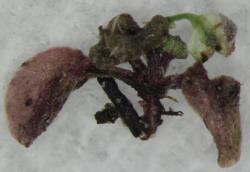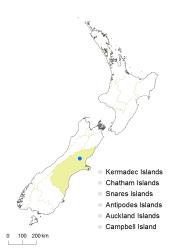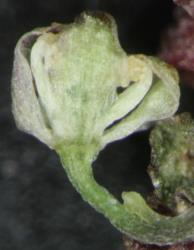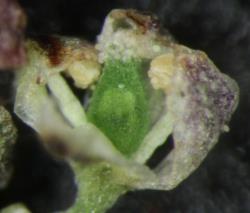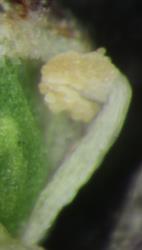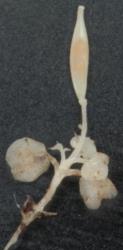Annual herb, 3.0–5.5 mm across, single stem, not branched; stems glabrous. Cotyledons persistent, opposite, lamina 1.4–1.9 × 1.5–2.1 mm, pinkish purple, orbicular, apex retuse; petiole 0.7–0.8 mm long, pinkish. Leaves up to 2.2 mm long, simple or 1-pinnate; lamina green to purple-green, membranous, sparsely hairy on adaxial surface, glabrous on abaxial surface; hairs 0.2–0.25 mm long, spreading to patent, 1–2-septate; petiole 0.6–0.8 mm long. Terminal pinna 0.8–1.2 × 1.3–1.4 mm, simple, broadly orbicular, margins entire or shallowly 1–2-lobed, lobes with hydathodes, apex subacute to obtuse, usually with a distinct hydathode, base truncate to cordate. Lateral pinnae absent or 1–2, 0.2–0.3 × 0.2–0.3 mm, petiolule indistinct. Cauline leaves absent. Inflorescence single, racemose, racemes 1–2-flowered, flower 0.8–0.9 mm diam.; peduncle up to 1.4 mm long, c. 0.3 mm diam. at base, erect to ascending, glabrous. Pedicels c. 1.1 mm long, c. 0.2 mm diam., spreading to ascending, glabrous. Sepals 0.6–0.7 × 0.4–0.45 mm, elliptic-oblong, saccate, green or red-brown, glabrous, margin white and membranous, apex obtuse, base truncate; black-brown gland on adaxial surface of one sepal. Petals absent. Stamens 2; filaments 0.36–0.4 mm long, 0.06 mm diam., conspicuously bent 90° distally; anthers c. 0.14 mm long, cream to pale yellow, when dehiscent held slightly below the stigma. Ovary 0.5–0.55 mm long, 0.2–0.22 mm diam., ± terete, green, glabrous; ovules 2; style c. 0.03 mm long, ± terete; stigma c. 0.14 mm diam., white. Siliques c. 4.0 × c. 0.8 mm, glabrous, style c. 0.6 mm long, septum central vein absent; replum c. 0.3 mm wide, flattened. Seeds c. 0.8 mm long, c. 0.55 mm wide, shortly oblong, brown.
South Island: Canterbury.
Cardamine cubita is known from a single locality near the upper Ashley River in Lees Valley, North Canterbury (Heenan et al. 2013).
Cardamine cubita was originally collected from an area of about 20 m² in an extensive wetland with varying degrees of natural drainage, disturbance (including artificial drains), and plant composition (Heenan et al. 2013). This site is modified and occupied by indigenous and naturalised grasses, sedges, rushes, and herbs.
Cardamine cubita is assessed as having a conservation status of Data Deficient (de Lange et al. 2018), because the size of the single population and its security and/or threats are not known with certainty. A search for C. cubita at the known site in Ashley River in September 2015 by P.B. Heenan and B.P.J. Molloy, in the vicinity of the original collection, failed to locate any additional plants.
nrDNA ITS and cpDNA trnL intron and trnL–trnF intergenic spacer sequence data implies that C. cubita is related to C. hirsuta and not the other New Zealand species of Cardamine (Heenan et al. 2013).



